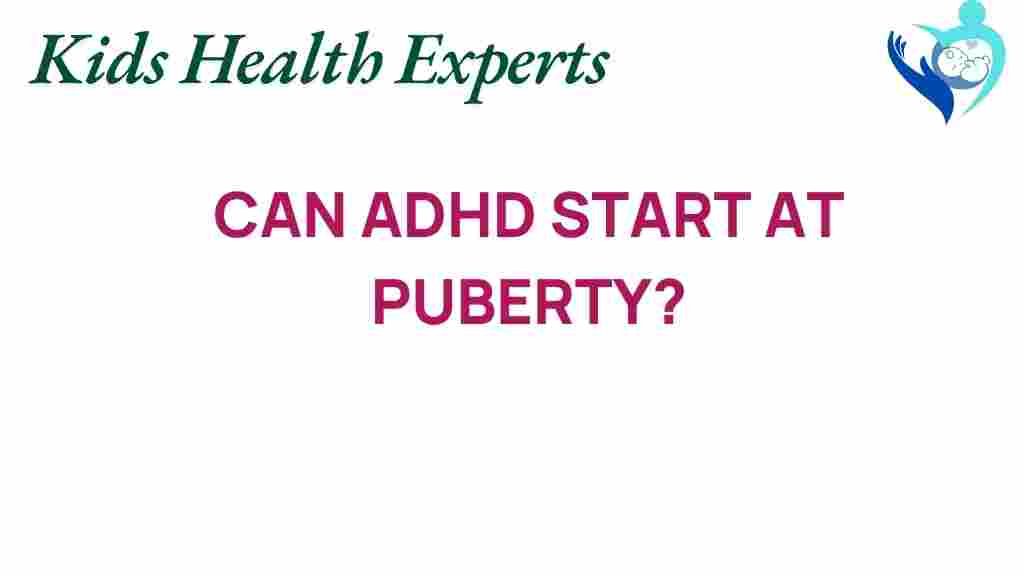Unraveling the Mystery: Can ADHD Manifest During Puberty?
Attention-Deficit/Hyperactivity Disorder (ADHD) is a complex neurodevelopmental condition that affects millions of children and often continues into adolescence and adulthood. As children transition into puberty, a stage marked by significant physical and emotional changes, many parents and educators wonder whether ADHD symptoms can emerge or become more pronounced during this critical developmental phase. This article delves into the relationship between ADHD and puberty, exploring symptoms, diagnosis, treatment, and the overall impact on mental health during adolescence.
Understanding ADHD and Its Symptoms
ADHD is characterized by a persistent pattern of inattention and/or hyperactivity-impulsivity that interferes with functioning or development. The symptoms can vary widely among individuals and may include:
- Inattention: Difficulty sustaining attention, careless mistakes, and trouble organizing tasks.
- Hyperactivity: Fidgeting, inability to stay seated, and excessive talking.
- Impulsivity: Interrupting others, difficulty waiting for turns, and making hasty decisions.
These symptoms can significantly impact a child’s academic performance, social interactions, and emotional well-being. As adolescents enter puberty, hormonal changes can exacerbate these symptoms or mask them, leading to further complications in diagnosis and treatment.
The Impact of Puberty on ADHD Symptoms
Puberty is a time of rapid change, marked by hormonal fluctuations that can influence behavior and mental health. For adolescents with ADHD, this period can bring about various challenges:
- Hormonal Changes: Hormones play a crucial role in mood regulation. Fluctuations can lead to increased irritability, anxiety, or mood swings, which may complicate existing ADHD symptoms.
- Social Pressures: Adolescents face heightened social expectations and peer pressures that can intensify feelings of inadequacy or frustration for those with ADHD.
- Academic Challenges: The transition to higher academic demands can reveal or exacerbate attention-related issues.
Understanding how these changes affect behavior is essential for parents, educators, and mental health professionals in supporting adolescents during this critical time.
Diagnosing ADHD During Adolescence
Diagnosis of ADHD is often conducted through a comprehensive evaluation process, especially during adolescence when symptoms may evolve. The steps include:
- Clinical Interview: Gathering detailed information from parents, teachers, and the adolescent about behavior patterns and functioning in various settings.
- Behavioral Assessments: Utilizing standardized rating scales and checklists to evaluate symptoms and their impact on daily life.
- Observation: Observing the adolescent in different environments, such as home and school, to assess behavior.
- Rule Out Other Conditions: Ensuring that symptoms are not attributed to other mental health disorders, such as anxiety or depression.
A proper diagnosis is crucial for effective treatment and management of ADHD symptoms during this turbulent time.
Challenges in Diagnosis
Diagnosing ADHD during puberty can be particularly challenging due to:
- Overlapping Symptoms: Symptoms of ADHD can overlap with common adolescent behaviors, making it difficult to distinguish between normal developmental changes and ADHD.
- Gender Differences: ADHD symptoms may manifest differently in boys and girls, with girls often exhibiting less hyperactivity and more inattentive symptoms, which can lead to underdiagnosis.
- Stigma and Awareness: There can be a stigma attached to mental health issues, leading some adolescents to hide their symptoms or avoid seeking help.
Providers must be aware of these challenges to ensure proper identification and support for adolescents struggling with ADHD.
Treatment Options for ADHD in Adolescents
Effective treatment for ADHD during puberty often requires a multifaceted approach, including:
- Medication: Stimulant medications, such as methylphenidate and amphetamines, are commonly prescribed and can help manage symptoms. Non-stimulant options are also available.
- Cognitive Behavioral Therapy (CBT): This form of therapy can assist adolescents in developing coping strategies and improving organizational skills.
- Parental Training: Educating parents about ADHD can enhance their ability to support their child’s needs.
- School Interventions: Collaborating with schools to implement Individualized Education Plans (IEPs) or 504 plans can provide necessary accommodations.
Combining these strategies can significantly improve outcomes for adolescents with ADHD, especially during the tumultuous puberty phase.
Behavioral Strategies to Manage ADHD Symptoms
In addition to professional treatment, several behavioral strategies can be beneficial for managing ADHD symptoms during adolescence:
- Establish Routines: Consistent daily routines can help adolescents stay organized and reduce anxiety.
- Break Tasks into Smaller Steps: Dividing tasks into manageable parts can prevent overwhelm and promote completion.
- Use Visual Aids: Charts, planners, or reminder apps can assist with organization and time management.
- Encourage Physical Activity: Regular exercise can help reduce hyperactivity and improve focus.
These strategies, when incorporated into daily life, can assist adolescents in navigating the challenges associated with ADHD during puberty.
Troubleshooting Tips for Parents and Caregivers
Parents and caregivers play a crucial role in supporting adolescents with ADHD. Here are some troubleshooting tips:
- Maintain Open Communication: Encourage your adolescent to express their feelings and challenges openly.
- Monitor Changes: Keep track of any changes in behavior or academic performance to discuss with healthcare providers.
- Be Patient: Understand that adolescence is a challenging time and that managing ADHD requires time and effort.
- Seek Support: Connecting with support groups or mental health professionals can provide additional resources and insights.
By implementing these strategies, parents can foster an environment that supports their adolescent’s mental health and development.
ADHD can indeed manifest or become more pronounced during puberty, making this a critical time for intervention and support. Understanding the symptoms, challenges in diagnosis, and effective treatment options is essential for parents, educators, and healthcare providers. With the right support, adolescents can navigate the complexities of ADHD during this transformative stage of life.
For more information on ADHD, mental health, and adolescent development, consider visiting the National Institute of Mental Health for resources and guidance. Additionally, parents may find it helpful to connect with local support groups or professional networks to share experiences and strategies.
This article is in the category Mental and created by KidsHealthExperts Team

1 thought on “Unraveling the Mystery: Can ADHD Manifest During Puberty?”